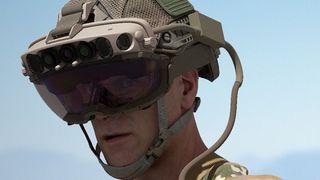US Army asks if Microsoft could please make its Kill-O-Vision headsets a bit cheaper
$22 billion doesn't go as far as it used to.

In 2021, Microsoft signed a $22 billion deal with the US Army to develop the Integrated Visual Augmentation System (IVAS), based on its HoloLens headset. Not everyone was thrilled with the idea of producing AR headsets for the US military—intended to improve "situational awareness, target engagement, and informed decision-making"—and, as usual with military procurement, there were bumps and delays along the way, but despite all of that the program continued to grind forward. Now, however, the IVAS headset is facing potentially its biggest challenge yet: They're just too damn expensive.
A Bloomberg report says the army plans to order up to 121,000 IVAS headset, depending on the outcome of testing that's scheduled to wrap up in mid-2025. Tests are currently "going much better than the first time around," Army acquisition chief Doug Bush said at the recent Association of the US Army conference, and "a lot of the problems [in earlier iterations] have been fixed." But sticker shock remains: The headsets are currently projected to sell for $80,000 each, and the army wants them to come in a "substantially less" than that.
That's an all-in price: The IVAS itself costs around $42,000 to produce, but other expenses, like Army program management and software support, also have to be factored in. Microsoft corporate vice president for mixed reality Robin Seiler said the company is now "going through the program to identify where we can reduce costs."
"It's a fairly complex system, so when you look at cost reduction you have to look at it from a component level, from a labor level and from your supply chain," Seiler said.
It's not terribly surprising that a government agency wants stuff to be cheaper than a massive corporate conglomerate would like to charge, but this isn't the first time the IVAS has come under fire for its price tag.
In 2022, the US Department of Defense (via TechSpot) warned the program "could result in wasting up to $21.88 billion in taxpayer funds" because it wasn't clear whether soldiers in the field would actually use the things. Which was, and is, a fair concern: Business Insider reported that same year that complaints about the headset at that stage of development included size, weight, loss of peripheral vision, and most notable, the glow from the display, which could apparently be seen from a very long distance, giving away the wearer's location. (It looks cool on Sam Fisher, yes, but in the real world, as one tester put it, "the devices would have gotten us killed.") Then in 2023, US Congress blocked the Army's plan to buy 6,900 of the headsets for $400 million; instead, it awarded Microsoft another $40 million to build a better one.
Microsoft ended production of the HoloLens 2 headset earlier this month but told UploadVR it remains "fully committed" to developing the IVAS.
The biggest gaming news, reviews and hardware deals
Keep up to date with the most important stories and the best deals, as picked by the PC Gamer team.
Andy has been gaming on PCs from the very beginning, starting as a youngster with text adventures and primitive action games on a cassette-based TRS80. From there he graduated to the glory days of Sierra Online adventures and Microprose sims, ran a local BBS, learned how to build PCs, and developed a longstanding love of RPGs, immersive sims, and shooters. He began writing videogame news in 2007 for The Escapist and somehow managed to avoid getting fired until 2014, when he joined the storied ranks of PC Gamer. He covers all aspects of the industry, from new game announcements and patch notes to legal disputes, Twitch beefs, esports, and Henry Cavill. Lots of Henry Cavill.
Most Popular








